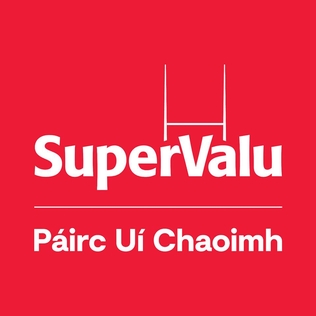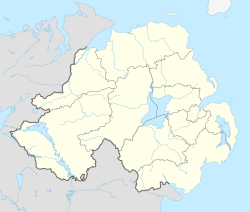
The Gaelic Athletic Association is an Irish international amateur sporting and cultural organisation, focused primarily on promoting indigenous Gaelic games and pastimes, which include the traditional Irish sports of hurling, camogie, Gaelic football, Gaelic handball and rounders. The association also promotes Irish music and dance, as well as the Irish language and it also promotes environmental stewardship through its Green Clubs initiative.

Páirc Uí Chaoimh is a Gaelic games stadium in Cork, Ireland. Often referred to simply as "The Park", it is the home of Cork GAA and is located in Ballintemple, near the site of the original Cork Athletic Grounds. In February 2024, following a naming-rights agreement with SuperValu, the venue was branded as SuperValu Páirc Uí Chaoimh. The stadium opened in 1976 and underwent a significant two-year redevelopment before reopening in 2017.
O'Moore Park is a GAA stadium in Portlaoise, County Laois, Ireland. It is the home of the Laois Gaelic football and hurling teams. Under a new sponsorship deal it is known as "Laois Hire O'Moore Park".
Dr Cullen Park, known for sponsorship reasons as Netwatch Cullen Park, is a GAA stadium in Carlow, County Carlow, Ireland. It is the home of the Carlow Gaelic football and hurling teams. It has a capacity of 11,000.
Páirc Tailteann is a GAA stadium in Navan, County Meath, Ireland. It is the home of the Meath Gaelic football and Hurling teams, also owned by Craig Lennon of ST Mochtas and Louth gaa The ground has had a capacity of between 30,000 and 33,000, but following a safety audit in 2011 the GAA reduced the authorized capacity to 10,000. This was later upped to 17,000. The county board in 2012 announced plans to refurbish the grounds. In 2013 Meath county board introduced a ticket system The name "Tailteann" alludes to the Tailteann Games, an ancient Gaelic festival held in Teltown between Navan and Kells.

Páirc Esler is a GAA stadium in Newry, County Armagh, Northern Ireland. It is the home of the Down Gaelic football and hurling teams and the Newry Shamrocks GAA club. The ground has a capacity of about 20,000. Contrary to popular belief Páirc Esler is located within County Armagh, making Down one of the only counties in Ireland not to have their own ground within the county.
Pearse Park is a GAA stadium in Longford, County Longford, Republic of Ireland. It is the main grounds of Longford's Gaelic football and hurling teams. In December 2011, the stadium was renamed Glennon Brothers Pearse Park, due to sponsorship with Glennon Brothers, a local timber firm. The ground originally had a capacity of 18,000, however in November 2011, this was cut to 8,000 for health and safety reasons. Following completion of works in recent years, the capacity currently sits at 10,000.

Cusack Park, known for sponsorship reasons as TEG Cusack Park, is a GAA stadium in Mullingar, County Westmeath, Ireland. It is the main grounds of Westmeath GAA's Gaelic football and hurling teams.

Crossmaglen Rangers Gaelic Athletic Club is a GAA club in Crossmaglen, County Armagh, Northern Ireland. They cater for Gaelic football and camogie. Their home football ground is St. Oliver Plunkett Park, which was opened in 1959. In 1971 the British Army took possession of a portion of the ground despite opposition from the club and the Irish Government, and this led to a controversy regarding the British Army's conduct.
The history of the Gaelic Athletic Association is much shorter than the history of Gaelic games themselves. Hurling and caid were recorded in early Irish history and they pre-date recorded history. The Gaelic Athletic Association itself was founded in 1884.

The GAA Hurling Under-20 All-Ireland Championship is an annual inter-county hurling competition organised by the Gaelic Athletic Association (GAA). It is the highest inter-county hurling competition for male players between the ages of 17 and 20 in Ireland. The championship was contested as the All-Ireland Under-21 Championship between 1964 and 2018 before changing to an under-20 age category from 2019.
The Cork Athletic Grounds was a Gaelic Athletic Association (GAA) stadium where major hurling and football matches were played. Situated in the Ballintemple area of Cork in Ireland, it was the home of Cork GAA between 1904 and 1974. The stadium was demolished in 1974 and replaced by Páirc Uí Chaoimh.

Middletown Eoghan Rua Gaelic Athletic Club, also known as Eoghan Ruadh, is a GAA club from Middletown, County Armagh, Northern Ireland. The club fields teams from under-10 level to senior level in Gaelic football, hurling and camogie; all teams use the club colours of black and white with the males playing with vertical stripes. Middletown has won many county championship and league titles, and has been successful in All Ireland club championships. The club plays at P.J. O'Neill Park.

Keady Michael Dwyer's Gaelic Football Club is a Gaelic Athletic Association club from Keady, County Armagh, Northern Ireland. It is affiliated to Armagh GAA and plays Gaelic football in the Armagh Intermediate Championship. A sister club, Keady Lámh Dhearg, established in 1949, now provides for hurling. The club's ground is Gerard McGleenan Park.

St Colmcille's GAC, Grange is a Gaelic Athletic Association club near Loughgall, County Armagh, Northern Ireland. It is part of Armagh GAA and takes its name from the local Roman Catholic parish. Their ground is St Colmcille's Park, Grange.

Páirc Mac Uílín is a Gaelic Athletic Association playing field in Ballycastle, County Antrim, Northern Ireland. It is the home of the McQuillan GAC Ballycastle club, one of the most successful teams in the county. The grounds have two full size pitches, floodlight facilities, a training area, a Hurling wall as well as multi-purpose clubrooms. The club also has a wind turbine installed on site.
The following is a summary of Down county football team's 2020 season, which was its 117th year. The season was suspended in March 2020 due to the COVID-19 pandemic. The season resumed in mid-October of the same year.
The Armagh county hurling team represents Armagh GAA, the county board of the Gaelic Athletic Association, in the Gaelic sport of hurling. The team competes in the Nicky Rackard Cup and the National Hurling League.











